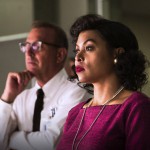Mathematicians and movies have long been strange bedfellows. Math is complicated, internal and not easily expressed visually. At the same time, those amazing humans who can see deeply into mathematical worlds off-limits to the rest of us can be utterly fascinating.
Opening on February 22 in Philippine cinemas from 20th Century Fox, “Hidden Figures” takes the audience back in the turbulent 60s, battling discrimination at home and in the workplace, Katherine Johnson, (Taraji P. Henson) Dorothy Vaughan (Oscar winner Octavia Spencer) and Mary Jackson (Janelle Monáe), all stellar mathematicians, were undeterred in their pursuit of academic excellence. Instrumental in helping America to eventually win the space race, they broke down barriers, laying the groundwork for future generations. Oscar winner, Kevin Costner, plays their supervisor at NASA. The exciting and engrossing film was directed by Ted Melfi and features a strong supporting cast, including Kirsten Dunst and Jim Parsons. There is a powerful score from multiple Grammy winning musician/composer Pharrell Williams.
This year’s strongest Oscar contender for Best Picture, “Hidden Figures”, directed by Theodore Melfi, relates the little known story of three pioneering black women – Katherine Johnson, Dorothy Vaughan and Mary Jackson, all math wizards at NASA, who had a formidable impact on history. Known as ‘colored computers’, they crossed racial and gender boundaries in the challenging fields of analytical geometry, engineering and rocket science. Defying the odds in the face of prejudice, they combined courage with intellectual rigor, pursuing excellence and helping America to ultimately win the Space Race. Great role models, they also paved the way for future generations.
Yet remarkably, until now, hardly anyone knew their names. “Hidden Figures” focuses on the lives of NASA’s African-American women as they struggle to solve brain-twisting problems while also breaking down barriers – but it was also essential to get the numbers that meant so much to them right. After all, just one degree off in their equations could have meant unthinkable tragedy for NASA.
“The idea of STEM is very important to this film,” says Williams. “I consider math to be a real art and it’s also a universal language. It doesn’t even matter what solar system you’re in, math applies.”
Williams is excited for today’s audiences to have the chance to meet Katherine G. Johnson, Dorothy and Mary. “She (Katherine) is someone who while surrounded by the darkness of the past, saw the future. She saw a future where woman superseded all expectations and were equally valued – and the sooner we all see that, I think the better our planet will be,” he sums up.
Says director Ted Melfi, “In this story, you see how skill and knowledge are equalizers. During the space race, when we put everything aside and said, ‘whatever race or sex you are, whatever background you have, if you can do the math, please help us get to the moon’ something amazing happened. People were valued for their talents and in turn gave their country valuable and precious gifts.”
He concludes: “A country divided along any lines can accomplish little, but a country united and inspired to work together can achieve the very best.”

![3 Significant Figures Behind Nasa’s ‘Hidden Figures’ [VIDEO]](https://files.tempo.com.ph/wp-content/uploads/2017/02/Janelle-Monae-as-Mary-in-HIDDEN-FIGURES-copy.jpg)










